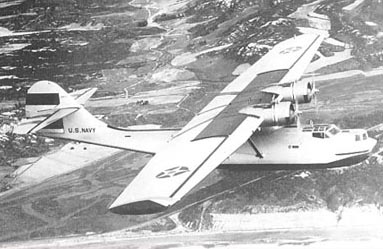The Catalina was manufactured principally at the Douglas plant at San Diego, California, to which the company had moved in the autumn of 1935, the Catalina maritime patrol flying boat was a classic aircraft produced in larger numbers than any other flying boat before or since. Better known as the 'Cat', it was dubbed 'Catalina' by the RAF, which placed large orders for the flying boat. The name was adopted by the Americans only in 1942. The PBY-5A of 1939, with retractable landing gear, was called the Canso by the Royal Canadian Air Force. The flying boat's features included two 825 hp Twin Wasp engines mounted close together on a wide clean wing, on the tips of which were located retractable stabilising floats. The Consolidated Model 28, or Navy XP3Y-1, recorded a speed of 184 mph, exceptionally high for a 1935 flying boat. The original order for 60 was also exceptional for the 1930s, but within 10 years, the world-wide total had exceeded 4,000. All versions of the Catalina were constructed of all-metal stressed skin. The wing was carried on a central pylon, and there were four small struts bracing the wide, untapered centre section. The hull was wide and shallow, with a round top. Wartime versions had a large observation blister on each side that could be swung open in flight. The majority of PBY-6As were equipped with ASV radar in a blister on a pylon mounted over the cockpit. Hundreds of the boat and amphibian Catalina variants were built by Canadian Vickers (PBV-1) and Boeing Canada (PB2B-1). Revised tail-fin versions (PBY-6A) were made at a Convair plant in New Orleans and at the Naval Aircraft Factory in Philadelphia (PBN-1 Nomad). The Soviet Union also built a version of the Catalina - the GST - after importing theree American aircraft in 1938. The Catalina had a distinguished wartime career. One of them located the German battleship Bismark in mid-Atlantic in May 1941. On the 3rd of June, 1942 Patrol Squadron 12 started the Catalina's 'Black Cat' tradition of stealthy night operations. The aircraft's ruggedness was shown when one Catalina crossed the Atlantic and landed safely despite having had both ailerons torn off by a storm. After World War II, hundreds of Catalinas served in many countries, with some air/sea rescue versions carrying a lifeboat under each wing.
Specifications PBY Catalina Flying Boat
Wingspan 104ft. (31.7m.)
Length 63ft. 11in. (19.5m.)
Height 18ft. 10in. (5.65m)
Wing area 1,400 sq.ft. (130 sq.mtr.)
Weight (empty) 17,465 lbs. (7,974 kg.)
Weight (loaded) 34,000 lbs. (15,436 kg.)
Maximum Speed 196 mph
Cruising Speed 100 mph
Climb Rate to 5,000 ft. 4 min. 30sec.
Range at 100 mph 3,100 mls. (4,960 km.)
Powerplants 2 x 1,2000 hp Pratt & Whitney R-1830 Twin Wasp 14-cylinder two-row radials..
Armament(U.S.Navy) 1 x .30 in.or .50 in. Browning in nows; 1 x .50 in in each waist blister and 1 x .50 in 'tunnel' in underside behind hull step; wing racks for 2,000 or 4,000 lb. (907 or 1,814 kg.) bombs and other stores including 2 torpedoes or 4 x 325 lb. (147 kg.) depth charges.
![]()
